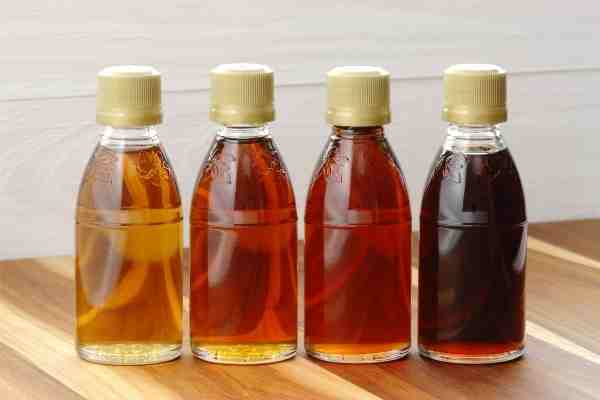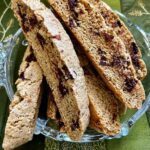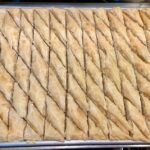Spring is the season for maple syrup production. As a naturalist, I try to eat what is in season and support local farms, community supported agricultures (CSAs), and farmers markets in my area. One of my favorite local products is maple syrup.
Maple syrup is versatile and delicious. It’s a great substitute for granulated sugar in nearly any recipe. Try syrup in a latte, in yogurt or baked beans, or on pancakes, walnuts, granola, or ice cream. Once you taste it, you may have difficulty going back to other sweeteners.
The color of your maple syrup depends on when it was collected.
The color of maple syrup has nothing to do with the grade (AA, A, or B) but rather how early the sap is collected. The earlier the sap is collected, the lighter and sweeter it is. Syrup that is collected later in the season has a darker appearance with heavier, more complex maple syrup taste.
There are many health benefits from maple syrup.
One tablespoon of maple syrup provides over 30% of the recommended daily value of manganese, a mineral that supports bone health, collagen production, and wound healing. Maple syrup also delivers smaller amounts of calcium, iron, potassium, and zinc. It has about 200 calories per 1/4 cup, zero cholesterol, and zero fat.
Most maple is organic, as it comes from trees in the forests where no herbicides, pesticides, or preservatives have been applied.
How Maple Syrup is Produced
Sugar maple trees need snow to grow. Each winter, a blanket of snow 8 inches deep or more covers about 65 percent of northeastern sugar maples. Without this insulating snow, the soil freezes deeper and longer, damaging the trees’ shallow roots.
Maple trees accumulate starch in their roots and trunks, especially in the period that precedes winter. The long accumulation of this starch makes it easy to convert it from its original state to sugar. Sugar maples have the highest concentration of sugar, approximately 2.5 percent more than other types of maple trees.
In January, harvesters install taps in the maple trees. They are placed about four-and-a-half feet up from the ground in a tree that is 12 inches or greater in diameter. Trees larger than 18 inches in diameter can accommodate two taps if placed correctly.
It takes about 43 gallons of sap to make one gallon of maple syrup.
According to the Historic Maple Archives at Cornell University, temperature fluctuations of warm days and freezing nights in early March trigger a cycle of sap flow throughout the tree. Warm temperatures above freezing cause pressure to build in the tree, which forces the sap to flow out of the tap lines and into collection receptacles. Then, when temperatures drop back down below freezing at night, suction in the tree pulls in more water to make more sap. Once daytime and nighttime temperature fluctuations lessen, the sap stops flowing.
Since sap contains a high water ratio – 98% water and only 2% sugar – it must undergo a heating process that evaporates the water, leaving a thick concentrated syrup behind.
Processing Maple Syrup on Different Scales
Experiencing maple syrup production first-hand is fascinating. If you have the opportunity to shadow a friend or visit a larger syrup production facility, it’s well worth it!
Small Batch Processing
I had the privilege of helping friends harvest maple syrup from trees in their backyard. My friends tapped, siphoned, and collected 60 gallons of sap. They then cooked the maple sap in a 20-gallon container for 8-10 hours, evaporating the water and leaving behind an amber syrup. In the final boil, they heated the syrup and filtered it three times to remove concentrated minerals. The 60 gallons of sap produced about 1 ½ gallons of syrup.
I visited the Maple Syrup Festival held in Thurman, NY in early March several years ago. It’s a great opportunity to learn more about the process of commercially-produced syrup. You can also visit some of the maple farms (ranging from 27 to 853 acres) which have been producing maple syrup for generations.
Commercial Batch Processing
Commercial maple production operations use similar siphoning techniques, but leverage machines to distill sap into syrup. After tapping and siphoning trees, harvesters run lines from the trees to an area where the collected sap is stored. The sap is then fed into an evaporator, where it is heated to remove excess moisture and concentrate the sugars. Once the maple syrup reaches a 66-67% sugar concentration, it is moved it to a finishing pan. Harvesters then cool, filter, grade, and bottle the syrup.
The History of Maple Syrup
Maple syrup is one of the oldest agricultural commodities produced in the U.S. According to Cornell University, sugarcane was grown in Brazil and the West Indies around the year 1500. Extracting sugar from maple trees (acer saccharum) was discovered shortly thereafter.
Historians debate about who first discovered the process of turning sap into syrup. One of the first references to maple sugar among the colonists dates back to 1664, when British officials mention sugar from trees in Massachusetts. A letter from 1684 indicates that Native Americans practiced the art of maple sugaring longer than any living among them can remember.
Several prominent men in history were involved with maple sugaring.
Benjamin Franklin encouraged massive sugar production in the Northeast to make the country less dependent on “foreign” sugar. Judge William Cooper (1754-1809), father of the journalist James Fenimore Cooper who held large acreage around Cooperstown, NY, bought maple sugar from the early settlers. Thomas Jefferson was an ardent advocate of large scale maple sugar manufacturing. He transplanted trees from New York State to establish a maple plantation on his Virginia Estate, Monticello in 1791.
For more information about the history of maple syrup production, visit the Maple Museum Centre located in Croghan, NY. Founded in 1977, the museum has preserved New York State’s maple legacy. You may also take a virtual tour of the facilities on their website.
Maple Syrup’s Grim Future
Unfortunately, climate change threatens maple syrup production. A study published in Global Change Biology warns that without snowpack, maple trees may grow up to 40 percent slower. As climate change reduces the amount of deep snow in New England, it could mean trouble for trees, humans, and the maple syrup industry.
Maple trees help syrup harvesters make a living while simultaneously depleting carbon pollution. Pamela Templer, a biology professor at Boston University, says forests can offset somewhere between 5 to 30% of US carbon emissions by pulling carbon dioxide out of the air and storing it. “If temperatures keep increasing and the snowpack keeps shrinking, it suggests that our maple forests are going to not grow as much and therefore not sequester as much carbon.”
According to the Urban Forestry Network, one sugar maple in one growing season can remove 60mg cadmium, 140mg chromium, 820mg nickel, and 5,200mg lead from the environment.
It’s so important to be stewards for the earth and to support sustainability efforts in your community. Help save maple trees and our planet by by joining the One Planet Life app. In the app, you can select a sustainability journey that can help guide you to reduce your carbon footprint. With the support of our passionate community of climate-focused individuals, you can make a difference!
This experience was shared by OPL Naturalist Yvonne Dwyer.
Learn more about Yvonne.

















